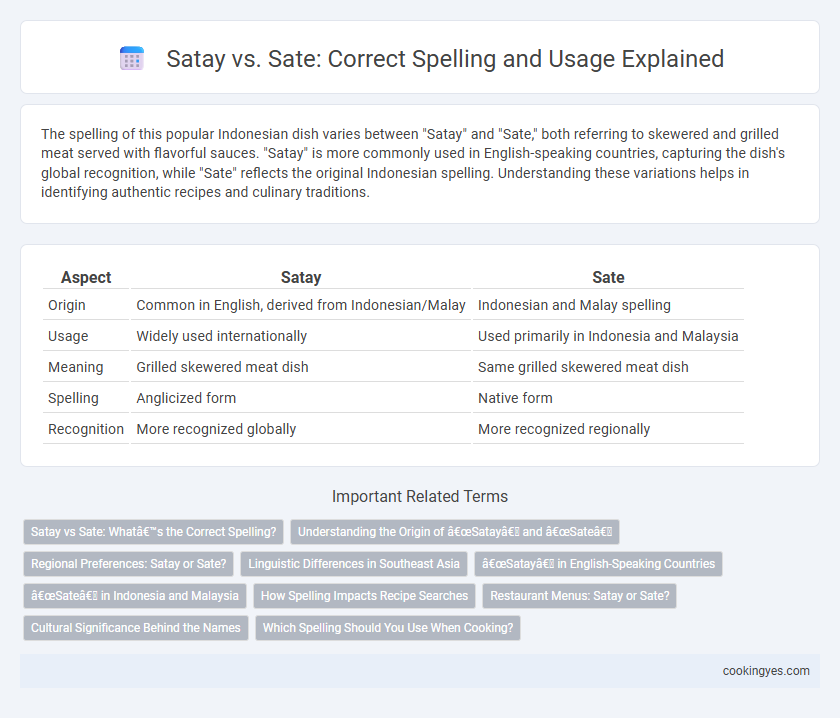The spelling of this popular Indonesian dish varies between "Satay" and "Sate," both referring to skewered and grilled meat served with flavorful sauces. "Satay" is more commonly used in English-speaking countries, capturing the dish's global recognition, while "Sate" reflects the original Indonesian spelling. Understanding these variations helps in identifying authentic recipes and culinary traditions.
Table of Comparison
| Aspect | Satay | Sate |
|---|---|---|
| Origin | Common in English, derived from Indonesian/Malay | Indonesian and Malay spelling |
| Usage | Widely used internationally | Used primarily in Indonesia and Malaysia |
| Meaning | Grilled skewered meat dish | Same grilled skewered meat dish |
| Spelling | Anglicized form | Native form |
| Recognition | More recognized globally | More recognized regionally |
Satay vs Sate: What’s the Correct Spelling?
Satay and Sate refer to the same Indonesian dish of grilled skewered meat, but the spelling varies by region and language influence. "Satay" is the English spelling widely used internationally, while "Sate" is the original Indonesian spelling. Both spellings are correct; the choice depends on the geographic context and audience familiarity.
Understanding the Origin of “Satay” and “Sate”
The terms "Satay" and "Sate" both refer to skewered and grilled meat dishes, originating from Indonesian cuisine, with "Sate" being the original Indonesian spelling and "Satay" adopted internationally. The spelling "Sate" is prevalent in Indonesia and reflects local pronunciation, while "Satay" gained popularity through English transliterations and global exposure. Understanding this linguistic evolution highlights the cultural transmission and adaptation of the dish beyond its Indonesian roots.
Regional Preferences: Satay or Sate?
Satay and sate refer to the same grilled skewered meat dish but reflect regional spelling differences, with "satay" commonly used in English-speaking countries and "sate" preferred in Indonesia and Malaysia. The variant "sate" aligns closely with the Malay and Indonesian pronunciation, while "satay" has become more widespread internationally through global culinary exposure. Understanding these regional preferences helps in accurately identifying the dish in different cultural and gastronomic contexts.
Linguistic Differences in Southeast Asia
Satay and Sate refer to the same skewered grilled meat dish, with spelling variations reflecting regional linguistic differences in Southeast Asia. In Indonesia and Malaysia, "Sate" is the common spelling, aligning with local Malay and Indonesian phonetics, while "Satay" is predominantly used in English-speaking countries to approximate the pronunciation. These variations highlight the influence of colonial languages and transliteration practices on the dish's name across the region.
“Satay” in English-Speaking Countries
Satay is the preferred spelling in English-speaking countries, reflecting its widespread recognition in global culinary contexts. The term "Satay" specifically denotes skewered and grilled meat dishes originating from Indonesia, commonly found in Southeast Asian cuisine. While "Sate" is also used, particularly in Indonesia, "Satay" dominates menus and food literature in English to ensure consistency and ease of understanding.
“Sate” in Indonesia and Malaysia
Sate" is the preferred spelling in Indonesia and Malaysia, reflecting local pronunciation and culinary tradition. This term distinguishes the dish as a popular Southeast Asian grilled meat skewer, deeply rooted in regional culture and street food. Using "Sate" emphasizes authenticity and aligns with Malay and Indonesian language norms.
How Spelling Impacts Recipe Searches
The spelling variations "satay" and "sate" significantly affect online recipe searches and user results due to regional differences and search engine algorithms prioritizing different terms. Using "satay" often yields more international recipes featuring skewered grilled meat with peanut sauce popular in Southeast Asia, while "sate" tends to bring up Indonesian-centric variations and local serving styles. Optimizing recipe content with both spellings can increase visibility, capturing a broader audience seeking authentic cooking techniques and ingredient lists.
Restaurant Menus: Satay or Sate?
Restaurant menus often feature the spelling "Satay" to cater to international customers familiar with the term, while "Sate" is commonly used in Indonesia and Malaysia, reflecting local linguistic preferences. Both terms refer to the same grilled meat skewers, but "Satay" appears more frequently on menus outside Southeast Asia due to its widespread recognition. Opting for "Satay" on menus can enhance accessibility and appeal to a broader audience seeking authentic yet approachable dishes.
Cultural Significance Behind the Names
Satay and Sate refer to the same traditional Southeast Asian dish of seasoned, skewered, and grilled meat, but the spelling variations highlight regional linguistic differences. Satay is commonly used in Indonesia and Malaysia, reflecting the Malay-Indonesian cultural heritage and its influence on the dish's global identity. The spelling "Sate" often appears in Indonesia, emphasizing local dialects and cultural nuances that preserve the dish's authentic roots and historical significance.
Which Spelling Should You Use When Cooking?
Satay is the more widely recognized English spelling for this Southeast Asian grilled meat dish, especially in international culinary contexts, while sate is commonly used in Indonesia and Malaysia. When cooking and sharing recipes with a global audience, using "satay" ensures better familiarity and understanding. Choosing "satay" enhances clarity in recipe communication and aligns with popular culinary references worldwide.
Satay vs Sate for spelling Infographic

 cookingyes.com
cookingyes.com